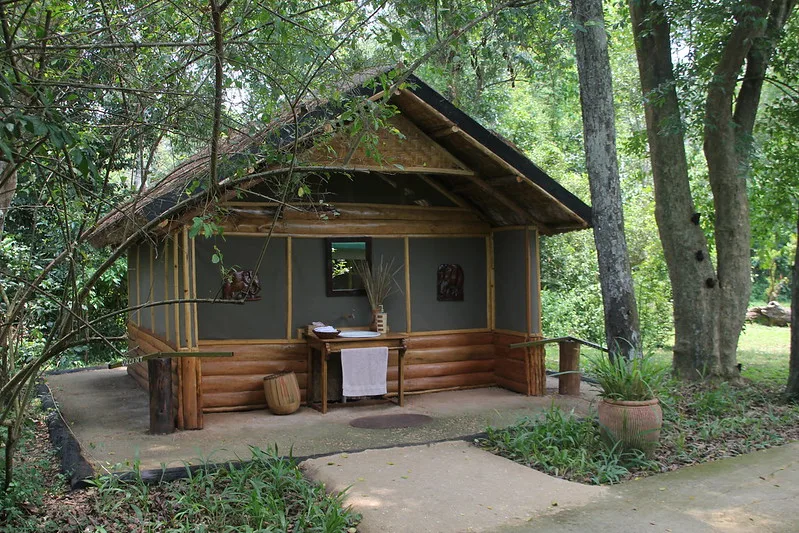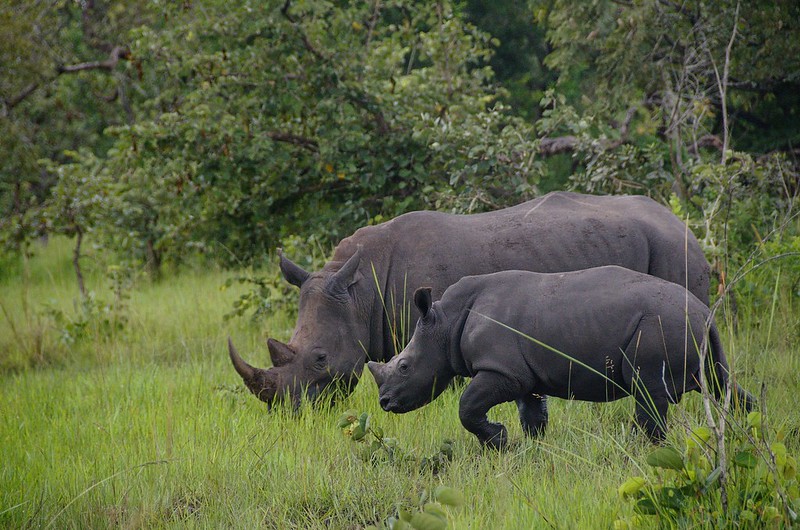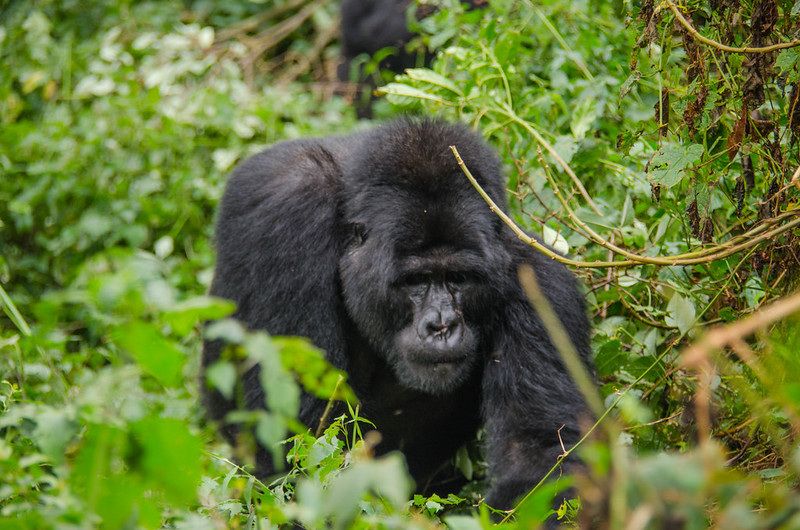Vous êtes bienvenus, aventuriers courageux, dans les merveilles sauvages de l'Ouganda, où l'appel de la…
Walking With Great Apes of Uganda
Gorillas & Chimps Habituation
On a gorilla and chimp trekking experience in Uganda, embark on a once-in-a-lifetime excursion into the rocky, lush jungles and walk with the big apes. Spend a day with a primatologist monitoring snooty chimp gangs and tracking mountain gorillas in the foggy mountain forests of Bwindi Impenetrable National Park.
Stay at luxurious safari lodges ranging from a savannah resort at the foot of the Rwenzori Mountains to a woodland cabin on a ridge with panoramic views of the Rift Valley and the Virunga Mountains. Rekindle your passion for true outdoor experiences on this bucket-list summer vacation suitable for a group of friends, coworkers, or you traveling alone.
Important Highlight
The entire trek is rated as moderately active. On some days, all tour participants should be physically healthy and prepared to walk or hike for several hours across difficult jungle terrain.
Second, on trekking trips, you may be out in the wilderness for up to 8 hours, through thick rainforest at heights of up to 3,000 meters (10,000 feet). Treks are unpredictable, with steep, uneven, damp, and sometimes muddy terrain. Every participant must be at least 15 years old.
Finally, unless you prefer regional planes, expect long driving days of up to 10 hours travelling between places.
Introduction to Uganda’s Great Apes in Entebbe, Ngamba Island Chimpanzee Sanctuary
Your arrival into Uganda will most likely be through Entebbe International Airport, which is located on a tiny peninsular at the northern shores of Lake Victoria, 35 kilometers outside of Kampala. Spend two nights here enjoying the highlights of Uganda’s wonderful experiences.![]()
Entebbe features a few of notable tourist sites that you might see at the start of your Uganda safari. These include following the massive shoebill bird in Mabamba swamps, visiting Jane Goodal’s orphaned chimps on an island off Lake Victoria’s northern shore, visiting the UWEC zoo, and birding in the Botanical Gardens.
Take a walk through the markets, golf course, or suburbian Entebbe surrounds if you love walking in a new city.
Your first encounter with Uganda’s big apes will be a day journey to Ngamba Chimp Island and the UWEC zoo on the shores of Lake Vicotria.
Entebbe to Kibale National Park is a 6-hour trip west on a well-paved roadway through Fort Portal town.
Check into your luxurious jungle hideaway, surrounded by exotic rainforests, huge trees, charming views, lush vegetation, and abundant birds. We want your encounter with Uganda’s great apes to have a good influence on the land and its natural inhabitants, thus sustainability is a major value in choosing your vacation resort.
Walking With Wild Chimpanzees in Kibale Forest On A Habituation Experience
The full-day Chimpanzee Habituation Experience starts about 6:00 a.m., soon as the chimpanzees leave their nests. It lasts until 7:00 p.m., when they construct their nests and retire for the night.![]()
Get up early for an early breakfast. You’ll bring a lunch pack, energy snacks, and a water bottle (preferably in a reusable can). After a briefing at the Kanyanchu Visitor Center, you’ll join the Chimpanzee Habituation team and go in search of a chimp’s nest.
When you discover the chimp tribe, you’ll spend the entire time following them, seeing their activities, hunting, eating, grooming, fornicating, battling for supremacy, and relaxing. The experience allows you to get near enough to the chimps to recognize their distinguishing traits and learn about their group dynamics.
Wild chimps are unapproachable; they will either terrified hide from people or attack us aggressively as a significant threat. Chimpanzee Habituation is the technique by which primatologists continually introduce human observers to a chimp group in order to diminish the chimps’ normally terrified reaction to human presence. The process can last up to two years and is recorded when the chimps regard the observers as neutral components in their surroundings.
The Chimpanzee Habituation Experience
During the Chimpanzee Habituation Experience in Kibale Forest, you will be following and monitoring a group that is aware of your presence but does not consider you a danger to their survival. However, the apes still regard your presence as a foreign element in their natural habitat. As a result, they’ll keep moving and spend less time around you.
The encounter with wild chimps may be physically hard, as you must trot or stroll to keep up with their activities; chimps are highly energetic and raucous animals. They’ll spend the most of the day drumming tree trunks, hopping and hooting in the forest canopy, although they’ll take a siesta or a break from their foraging missions.
On this chimp adventure excursion, the time spent on the ground will be some of your most treasured moments, and it’s the greatest time to take the ultimate monkey photographs.
You’ll return to the lodge whenever you’ve had enough, even before nesting time, to nurture your overly aroused muscles with a hot bath and food. You’ll stay at your forest lodge for another night (or two) before continuing south to the gorilla highlands.
Walking in The Valley of Apes and Game Viewing in Queen Elizabeth National Park
Queen Elizabeth Nation Park is roughly a 2-3-hour drive north of Kibale Forests on a smooth-surfaced road. Here you may get a short flight to Bwindi or stay the night before driving across the mountainous highlands for 6-7 hours.![]()
The travel from Kibale Forest to Bwindi takes around 9-10 hours; it is a difficult drive for a tourist. So, a relaxing night or two in a safari camp in QENP is a good way to break up the drive. A wildlife drive on the savannah plains and a boat safari on the Kazinga Channel are also available from here.
Queen Elizabeth National Park is Uganda’s most popular safari destination. You’re very certain to witness a variety of species, including lions, zebras, hippos, crocodiles, buffalos, elephants, and the elusive leopard. The interesting tree-climbing lions in the isolated Ishasha park area are a highlight. Nonetheless, the astonishing 116 bird species are highly appealing to bird lovers.
Aside from searching the wide savannah plains for wildlife in the back of a four-by-four safari truck, a Kazinga Channel boat safari allows you to get up up and personal with the savannah species. The 32-kilometer-long tranquil stream cuts through the park, creating a wildlife haven along its banks. It is well-known for having the world’s greatest hippo population. Many species, both large and little, flock to the Kazing channel waters. The boat tour will put you at arm’s length from the fearsome monsters while yet allowing you to get that stunning million-dollar image.
Walking With The Lost Great Apes
If you are interested in walking with Uganda’s great apes, then a stroll with the lost chimps of Kyambura Gorge will be your experience at Queen Elizabeth National Park. The ravine is a miniature Eden hidden under the plains, teeming with chimps and other monkeys shut off from the larger forest areas.
In the morning, you may spend an hour viewing a colony of human-habituated chimps in Kyambura Gorge (and another in the afternoon). Kyambura Gorge is one of the best sites in the world to watch chimps in the wild. Nature hikes in the subterranean rainforest are charming, bird viewing is excellent, and the vistas are breathtaking.
After your exciting stroll with the great apes, relax at the lodge with a golden sunset, a conversational campfire, or stargazing. The next morning, you will either travel by road (6 hours) or by local aircraft and transfer (1+2 hours).
Habituating The Wild Mountain Gorillas of Bwindi Impenetrable National Park
One of the final mountain gorilla habitats is Uganda’s Bwindi Impenetrable National Park. The 331-square-kilometer UNESCO World Heritage Site preserves half of the critically endangered mountain gorillas as well as other internationally vulnerable species like as chimps, I’Hoest’s monkeys, and African elephants.![]()
Bwindi is a birder’s paradise, home to rare species such as the Grauer’s swamp warbler, African green broadbill, Chapin’s flycatcher, Turner’s Eremomela, and Shelley’s crimson-wing. But, for the brave visitor anxious to stroll alongside Uganda’s giant apes, this is all nonsense.
Your tour manager will book you into one of the greatest gorilla eco-resorts, which include forest cottages that are beautifully raised above the jungle. These resorts boast of iconic vistas overlooking the rough Rift Valley, with the spectacular Virunga Volcanos in the background.
Tuck in early for an early wake-up call the next morning. The Rushaga Sector (south of Bwindi) Gorilla Habituation Experience begins very early in the morning when the gorillas leave their nocturnal nests.
What Does Gorilla Habituation Imply?
Wild gorillas, like wild chimps, are unapproachable; they avoid strange items or attack them aggressively if challenged. Researchers and hikers may get a close-up look at the endangered giant apes thanks to habituated gorillas. The gorilla habituation procedure takes three to five years to familiarize the apes with human presence without interfering with their natural lifestyle.
Habituation, in general, refers to a procedure in which humans (typically scientists and their helpers) continuously make non-threatening advances to gorillas until they lose their fear and disregard human presence. In other words, the people become a non-threatening element of the gorillas’ environment.’
The Gorilla Habituation Experience
Your gorilla habituation encounter in Rushaga will take place with a gorilla family that has partially completed this process and can tolerate your presence but is not totally receptive. As a result, you’ll be on your feet for at least four hours, following the great apes, rangers, and researchers everywhere they go.
Because the forest floor is moist, muddy, and uneven, make sure your best foot is clad in a comfy waterproof hiking shoe. The forest is damp and dense; a tracker will be machete-hacking his way through it. Wear covering clothing such as a long-sleeved t-shirt, long pants, and socks to tuck in your trouser ankle-endings to avoid mosquito bites and pricks.
You’ll be spending more time in the forest strolling with the apes, so bring a lunch pack, some energy snacks, and a can of drinking water to stay hydrated.
The duration of the experience
The complete Gorilla Habituation Experience, including the four hours spent viewing the natural gorilla troop, might last five to eight hours. The physical and social parallels between humans and mountain gorillas are astounding. Four hours spent strolling with the big apes will fly by like a hot summer breeze.
Fortunately, unlike their mischievous relative chimps, gorillas are peaceful creatures. As a result, you’ll spend the most of your excursion sitting calmly and watching them from 32 feet (10 meters) away. The rambunctious youngsters may approach you. Their enormous father may use threatening chest-thumps to show you who is boss; follow the guide/lead researcher’s and be subservient. Allow that adrenaline rush to stay; it is the excitement of true jungle adventures with wild monkeys.
Return to your woodland lodge for another royal treatment after your gorilla encounter. Spend another night or two before returning to the city; the scenery around Bwindi is worth a tranquil escape, and the executive secluded resort atmosphere is truly refreshing.
How long will this big ape expedition last?
The Gorilla & Chimpanzee Habituation Adventure might last eight (8) to twelve (12) days, or perhaps longer. Walking among Uganda’s great apes necessitates a calm, patient, and thoughtful demeanor in order to capture remarkable moments.
This entails devising a stress-free agenda that includes downtime at well chosen safari camps. You’ll need a tour manager who understands how to run such a once-in-a-lifetime event.
You might begin your adventure in Entebbe and then go to the high altitude gorilla trekking location, Bwindi Impenetrable Forest, for a walking safari, a wildlife drive in QENP, and a walk with wild chimps in Kibale Forest.
Regardless of whatever path you take, the gorilla and chimp habituation experience in Uganda is fantastic and should be on every adventure traveller’s bucket list this year.
When is the best time to visit Uganda’s great apes?
Because it is a private trip in a tropical climate, you may join the adventure to walk with the great apes of Uganda all year. Most visitors, however, would like to escape the severe rains of the rainy seasons, which last from March to May and September to November.![]()
The Best Weather
The two dry seasons, June-August and December-February, are ideal for trekking with wild chimps and gorillas since the pathways are dry and rain is unlikely. Nonetheless, tropical weather in the jungle should not catch you off guard when it rains; bring a light rain jacket, a waterproof bag, and rain boots to avoid rain surprises.
Periods of Heavy Rain
Heavy rains are expected in Uganda throughout the months of March-May and September-November, especially in the high altitude rainforests. Some visitors choose to avoid gorilla and chimp trekking adventures during the rainy season.
Although strolling with Uganda’s big apes during the rainy season has certain perks. For example, primates do not go far into the jungle since it is warmer near the outside of the forest. Furthermore, vegetables are healthier for a vegetarian diet.
Second, when the rains, the air is free of dust, which is ideal for photographers. Third, the tropical weather during the wet season creates a wilderness atmosphere that urges you to stare and admire nature for a little amount of time. That is not possible in the humid heat beneath the jungle canopy.
Finally, the rainy season is the shoulder/low travel season. You may take advantage of the savings offered by most forest lodges at that time. When you go during the shoulder months, you may save over 35% on your trip costs; contact your tour operator for additional information on the low season.
Trip Fees
The primary expenses for this all-inclusive off-the-beaten-path experience are gorilla and chimp permits, lodging, food, and transports between parks. You will also receive a return trip from Entebbe to your own nation. Local tour providers often do not deal with foreign flights, but instead handle all local logistics.
The Chimpanzee Habituation Excursion costs $250, which is just little more than the normal chimp trekking experience, which costs $200.
The Gorilla Habituation Permit costs $1,500, which is twice the cost of the usual gorilla trekking trip, which costs $700.
You can book the permit directly with the Uganda Wildlife Authority (UWA) or via a licensed operator like Monumental Expeditions and Tours. to avoid local logistics. The tour operator pays the government’s permission fees through UWA at face value (as mentioned) and will charge you just that unless the operator imposes logistical costs.
Pay for the permit as soon as it becomes available; permits are in short supply, which means you should prepare for your excursion months in advance.


